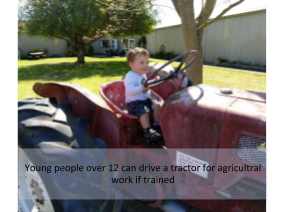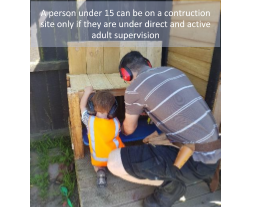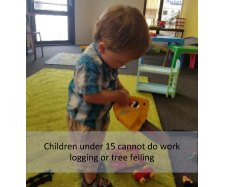Keeping Young People Safe in the Workplace
- Chris Brosnan
- Sep 27, 2021
- 3 min read
It is almost a Kiwi rite of passage to go and help at a family member’s place of work during the
school holidays to earn extra money, experience or both. A lot of us have fond memories of working alongside older family members and learning the skills of their trade over the summer.
However, it is important to know the laws and regulations regarding minors on worksites and ensure that they are kept safe. Generally, a young person under the age of 15 cannot be in the following areas or do work involving:
Manufacturing
Construction
Logging or tree felling
Hazardous substances
Any area or work that is likely to cause harm to a young person
They also cannot:
Work with machinery
Drive a vehicle or ride on a vehicle with something attached
Do work that requires lifting heavy weights
Work between the hours of 10pm and 6am
A young person 15 and older must still have the necessary site induction, training and PPE required for the workplace. They should also be supervised until deemed competent. Young people often are not as aware of potential hazards and risks in the workplace due to lack of experience.
They can be over-confident in their abilities, eager to please, thereby willingly taking on tasks that they might not be competent to carry out independently and putting themselves at risk.
As a PCBU you have the responsibility to provide a healthy and safe environment for young workers. Assessing and addressing the possible risks and ensuring the workplace remains safe for them. You should also educate any young person working for you of their responsibilities to do the following while at work:
Take reasonable care for their own health and safety at work
Ensure they don’t adversely affect the health and safety of others
Wear the PPE provided to them
Comply with any reasonable instructions
Cooperate with any reasonable health and safety policies and procedures
Let’s look at some examples of how the above can be applied in real life.
Example 1:
Chris the builder has two children 16-year-old Ally and 14-year-old Lachy. His children want to spend the summer helping with a new build he is undertaking. After assessing the risks Chris decides that due to his age Lachy would not be able to come on site and work.
Ally would be able to but she would have to be inducted like anyone else coming onto the site, would have to have the required PPE that fits correctly and, until trained and deemed competent, would only be able to undertake a person under 15 can be on a construction site only if they are under direct and active adult supervision work under direct supervision that is considered safe and appropriate for her age.
To include Lachy, Chris arranges to take him on several supervised tours of the worksite when hazardous work is not underway and teach him some construction skills at home in preparation for the following summer when he will be old enough to work on site.
Example 2:
Michelle is a contract courier. Her 13-year-old son Jesse wants to help her with deliveries over the Christmas break. After accessing the possible risks Michelle decides that Jesse would be able to ride with her and accompany her on deliveries provided he is not left unattended in the vehicle with keys, wears the same PPE she does, is not made to carry heavy packages, and does not accompany her out of the vehicle onto sites his age excludes him from being on.
Example 3:
Sam is the manager of a small ice cream factory. His children 15-year-old Liam and 12-year-old Amelia want to work in the factory to earn money over the holidays. After a discussion of the risks with his production manager Sam allows Liam to work in the production line as trainee under the supervision of the production manager.
He must undergo the same induction and training as other trainee production workers. Due to her age Amelia is not able to safely work in the plant so he arranges for her to work as an assistant to the office manager, helping with administrative work in non-production areas of the factory.
He arranges for the plant manager to take her on a guided tour of the factory so she can see how the production process works. Health and safety rules for young workers is not about excluding them; it is about identifying and managing risk effectively so they can take part in a safe and appropriate way.
For further information about having young people in the workplace
Special Thanks to Lachlan for providing photos of someone who has a few more years to go before he can go to work with dad 🙂





Comments